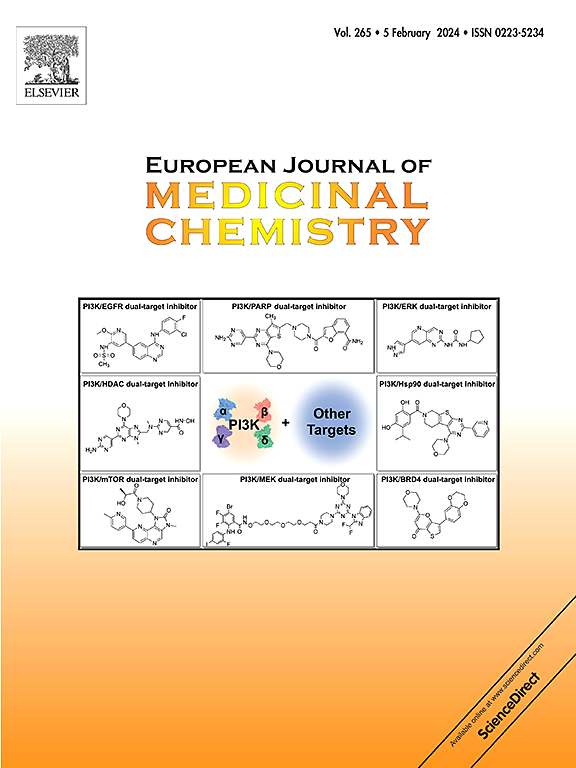A Cinderella story in antimicrobials: CDPDP's perfect fit for multiple-pathway bacterial inhibition
IF 5.9
2区 医学
Q1 CHEMISTRY, MEDICINAL
引用次数: 0
Abstract
The rapid rise of antibiotic resistance among bacterial pathogens threatens global health, rendering many existing drugs ineffective and creating an urgent demand for new therapeutic strategies. To the best of our knowledge, this is the first work reporting the detailed antibacterial mechanism of action of twelve targeted genes. Here, we evaluated the marine‐derived compound CDPDP for its antibacterial activity against Staphylococcus aureus (S.A.) and Riemerella anatipestifer (R.A.), demonstrating potent bactericidal effects (IC50 = 300 μM for S.A.; 100 μM for R.A.). Scanning electron microscopy revealed pronounced morphological alterations in treated cells, including cell shrinkage, membrane blebbing, and wall irregularities. Comparative transcriptome analysis uncovered that CDPDP exerts its antibacterial activity in S.A. primarily through targeting DNA/nucleic acid‐binding genes—downregulating key replication and repair factors (SSB, DnaN, RecF, MutS, PolA, LigA)—while in R.A. it disrupts membrane integrity by suppressing genes involved in outer‐membrane biogenesis and protein translocation (SecY, SecG, TatA, YajC, MurC, AccB). Validation via qRT‐PCR consistently confirmed the RNA‐Seq differential expression patterns, verifying the downregulation of DNA-binding and membrane-associated genes in both pathogens after CDPDP treatment, and molecular docking identified crucial amino acid interactions mediating CDPDP binding (Arg1086/Thr1098 in SSB; Phe78/Ile82 in SecY). Molecular dynamics simulations further substantiated the stability of these interactions under physiological conditions. Additionally, in silico epoxidation and N‐dealkylation predictions reveal potential metabolic transformations that could influence CDPDP's bioactivity. Collectively, these findings unveil a dual antibacterial mechanism—DNA‐targeted lethality in Gram‐positives and membrane disruption in Gram‐negatives—demonstrating CDPDP's potential as a broad-spectrum, resistance-resilient antibiotic lead.


抗菌剂的灰姑娘故事:CDPDP对多途径细菌抑制的完美契合
细菌病原体中抗生素耐药性的迅速上升威胁到全球健康,使许多现有药物无效,并迫切需要新的治疗策略。据我们所知,这是第一次报道12个靶向基因的详细抑菌机制。本研究对海洋衍生化合物CDPDP对金黄色葡萄球菌(S.A.)和鸭疫里默氏菌(R.A.)的抑菌活性进行了评价,结果表明,CDPDP对金黄色葡萄球菌(S.A.)和鸭疫里默氏菌(R.A.)具有较强的杀菌作用(IC50 = 300 μM;100 μM (R.A.)。扫描电镜显示处理后的细胞有明显的形态学改变,包括细胞收缩、膜起泡和壁不规则。对比转录组分析发现,CDPDP在sa中主要通过靶向DNA/核酸结合基因(下调关键复制和修复因子(SSB、DnaN、RecF、MutS、PolA、LigA)发挥抗菌活性,而在ra中通过抑制参与外膜生物发生和蛋白质易位的基因(SecY、SecG、TatA、YajC、MurC、AccB)破坏膜完整性。qRT - PCR验证一致证实了RNA - Seq差异表达模式,验证了CDPDP处理后两种病原体中dna结合和膜相关基因的下调,分子对接鉴定了介导CDPDP结合的关键氨基酸相互作用(SSB中的Arg1086/Thr1098;Phe78/Ile82 in SecY)。分子动力学模拟进一步证实了这些相互作用在生理条件下的稳定性。此外,硅环氧化和N -脱烷基预测揭示了可能影响CDPDP生物活性的潜在代谢转化。总的来说,这些发现揭示了双重抗菌机制-革兰氏阳性的dna靶向致病性和革兰氏阴性的膜破坏-证明了CDPDP作为广谱,耐药弹性抗生素铅的潜力。
本文章由计算机程序翻译,如有差异,请以英文原文为准。
求助全文
约1分钟内获得全文
求助全文
来源期刊
CiteScore
11.70
自引率
9.00%
发文量
863
审稿时长
29 days
期刊介绍:
The European Journal of Medicinal Chemistry is a global journal that publishes studies on all aspects of medicinal chemistry. It provides a medium for publication of original papers and also welcomes critical review papers.
A typical paper would report on the organic synthesis, characterization and pharmacological evaluation of compounds. Other topics of interest are drug design, QSAR, molecular modeling, drug-receptor interactions, molecular aspects of drug metabolism, prodrug synthesis and drug targeting. The journal expects manuscripts to present the rational for a study, provide insight into the design of compounds or understanding of mechanism, or clarify the targets.

 求助内容:
求助内容: 应助结果提醒方式:
应助结果提醒方式:


